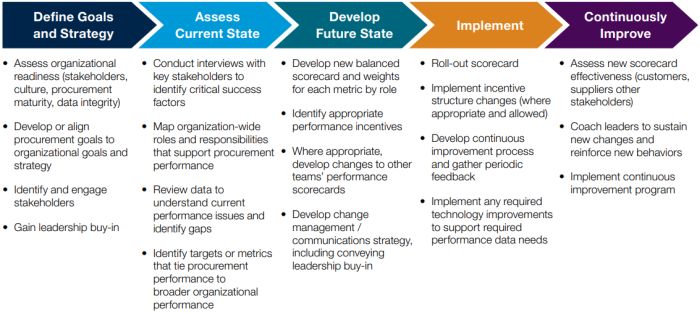- within Insolvency/Bankruptcy/Re-Structuring, Law Department Performance and Criminal Law topic(s)
The Situation Today
Federal agencies spent more than $600 billion on contracts last year, almost 20 percent of that in September. That rush in spending can't be a good business practice. What can government procurement shops do to better manage their spending? Leading organizations rely on a tried-and-true tool to better manage their spending: the balanced scorecard.
In addition to waiting until the last minute to issue contracts, there is an array of additional challenges in government contracting. Skill gaps, poor transparency and fraud are just some of the issues procurement officials must navigate. A comprehensive procurement plan aligned with strategic goals, effective performance metrics and robust training and development for staff are key ingredients in a wellfunctioning procurement operation. The Government Accountability Office (GAO) wrote in 2021 that procurement leaders could improve the use of metrics, including outcome-oriented metrics, in their acquisitions.1 Adherence to the dizzying acquisition regulations is also critical to ensure fairness and reduce the chance of protests.
A balanced scorecard would provide procurement executives with the insights they need to better manage contract operations. Prior to rolling out any metrics or scorecard program, though, the procurement organization should assess (1) its overall maturity in systems, processes, and people to understand readiness to implement a balanced scorecard, and (2) tie any metrics to broader organizational objectives and strategy. Let's assume you're there. What next?
How Balanced Scorecard Can Increase Performance
With over $600 billion in annual spending on goods and services, it is essential that a procurement executive has a holistic view of their organization's performance. The balanced scorecard can help organizations accomplish this by 1) aligning performance measurement with strategic goals; 2) focusing performance metrics on all aspects of the organization; and 3) promoting accountability across the organizations from leadership to contracting end-users.
- Alignment with Strategic Objectives: The balanced scorecard allows executives to measure whether activities and processes of the procurement office are aligned with the organization's strategic objectives. Moreover, it enables clear communication of these objectives throughout the organization, guiding decision-making and resource allocation. Is the organization's planned procurement spending aligned with the leadership's top priorities? Is there room to reallocate contract dollars to better achieve the organization's mission? These are questions that a balanced scorecard can help answer.
- Focused Performance Metrics: By defining specific performance metrics for each perspective, the procurement office can concentrate on what matters most to achieve its strategic goals. This prevents a narrow focus solely on financial metrics and encourages the consideration of other critical factors. Per the 2021 GAO report, procurement organizations' outcome measures should track (1) cost savings/avoidance, (2) timeliness of deliveries, (3) quality of deliverables and (4) end-user satisfaction.
- Organizational Accountability: The balanced scorecard holds individuals and teams accountable for their contributions to performance. It encourages a sense of ownership and responsibility for achieving objectives across various dimensions. The balanced scorecard may rely on disparate data sources to track performance and, if so, it is essential that all parties involved be included in continuous reviews of performance.
Using a balanced scorecard in a procurement office can lead to more well-rounded and effective performance management, aligning activities with strategic objectives and improving decision-making at various levels of the organization. More importantly, it can help the organization demonstrate return on investment not only from overall contract spending, but in the procurement organization, itself.
A&M's Approach
Although each organization will require a customized approach to develop its own balanced scorecard, below is a sample, high-level approach to this implementation:

Case Study: A Large Travel and Logistics Organization Getting Back-on-track
Situation: A multi-billion-dollar travel and logistics organization is working to expand its domestic and international presence. The organization has rudimentary forecasts and key performance indicators (KPIs) for its procurement and finance teams and did not provide proper visibility to assess if it was meeting its strategic goals.
How We Helped the Client: A&M helped executives and heads of procurement and finance teams to understand how to develop and operationalize their strategy and measure their progress. A&M supported leadership in the following ways:
- Facilitated input from a diverse set of voices to understand the current procurement and financial processes, pain points and opportunities for improvement.
- Performed a detailed analysis to quantify opportunities, including process and metric benchmarking.
- Developed a roadmap, prioritizing short vs. long term opportunities.
- Developed a business case for key opportunities.
- Outlined a high-level implementation approach.
Outcome: A&M identified six key initiatives that would result in ~$7 million annual benefit in a steady-state environment. These initiatives included:
- Optimize Working Capital Strategy: Implement a dynamic discounting tool and negotiate standard payment terms with vendors.
- Improve Cross-functional Financial and Procurement Process: Deploy Lean process improvements, assess and implement RPA (Robotic Process Automation) opportunities.
- Implement OCR (Optical Character Recognition): Confirm OCR requirements and complete implementation.
- Mandate P-Cards for Employee Expenses: Implement policies and change management to transition to P-Card use.
- Refine and Implement KPIs: Design and implement cross-functional KPIs, build automated dashboard and create accountability and management plan.
- Implement a Supplier Portal: Develop requirements and select and implement a portal.
Why A&M
For more than 40 years, Alvarez & Marsal (A&M) has set the standard for helping organizations tackle complex business issues, boost operating performance and maximize stakeholder value. A&M Federal is a dedicated business group focused on delivering results to departments and agencies across the federal government. The Federal Practice assists both civilian and defense agencies with transformation to improve readiness, operations and optimize the capability of organizational assets. Among our most successful engagements are those that helped procurement offices transform their operations and drastically improve the outcomes they achieve with limited contract dollars
Footnote
The content of this article is intended to provide a general guide to the subject matter. Specialist advice should be sought about your specific circumstances.


